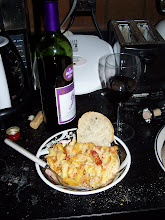 As the appointed crafty arm of the Stoned Soup Law I thought I'd share as my first project a craft that captures so many of the things dear to our hearts: kitchen equipment, recycling, being broke, handmade stuff. We at the SS Club pride ourselves on being able to whip up an amazing meal no matter how well-appointed or busted our kitchen situations happen to be. But there are certain things you can never have too many of, and one of them is potholders. (Ask any seasoned SSer who once reached for a hot panhandle because the smoke alarm woke them out of their spacey kitchen meditation or make-out session and burned themselves because there was no potholder at hand and OH MY GOD I JUST NEED THAT HORRIBLE BEEPING NOISE TO STOP and they will verify.) But who wants to spend money on potholders?
As the appointed crafty arm of the Stoned Soup Law I thought I'd share as my first project a craft that captures so many of the things dear to our hearts: kitchen equipment, recycling, being broke, handmade stuff. We at the SS Club pride ourselves on being able to whip up an amazing meal no matter how well-appointed or busted our kitchen situations happen to be. But there are certain things you can never have too many of, and one of them is potholders. (Ask any seasoned SSer who once reached for a hot panhandle because the smoke alarm woke them out of their spacey kitchen meditation or make-out session and burned themselves because there was no potholder at hand and OH MY GOD I JUST NEED THAT HORRIBLE BEEPING NOISE TO STOP and they will verify.) But who wants to spend money on potholders? Enter last year's jeans, the ones you turned into shorts over the summer. Maybe you were clever enough to knowingly save the chopped off leg parts for a future project. Maybe you just forgot about them and they got shoved under the bed where the kittens have been building forts out of them for the last 3 months. Either way, grab yourself some old denim (and make sure it's clean).
Moth holes in your favorite wool sweater? Accidently threw it in the dryer and shrunk it? Even better! This is a legit crafting process called "felting" so pretend like you meant to. It will make the fabric denser and easier to work with.
Cut squares of sweater material and denim in equal sizes, lining them up and ironing them on top of each other. A good hot iron is a really key piece of equipment in this project. Ironing the pieces together sort of helps them stick to each other a little. Note: Make sure your sweater is %100 wool. Sometimes synthetic materials will melt to an iron.
If you don't have a sewing machine, you can sew them together by hand, along each edge leaving a slight margin-- 5/8s of an inch is pretty standard.
I used a sewing machine for mine and here are some tips I pass along:
*set your stitch length long, it will be help accommodate the stretchiness of the sweater fabric
*sew with the denim side down-- the wool can snag on the teeth that help feed the fabric through the machine. Denim side down makes for a much smoother ride.
*the sweater fabric will want to shift and stretch on you, it's not the easiest stuff to work with. If you felted your material it will be a little stiffer and less stretchy, and this helps. Use your hands carefully to guide the fabric and keep it in place, especially once you are sewing the last side, sometimes it wants to bubble at the end of the final seam.
*Don't be too worried about the edges lining up, we'll take care of that in a minute. Be more concerned with the materials lying flat against each other.
When you are done, iron again, and trim the edges. Often the sweater material will have shifted a little, and trimming will make the edges look even and square.
Voila! Look at how ingenious and resourceful you are. Wool also has natural microbial properties so your kitchen is just a little more germ-resistant than if you were using boring regular potholders.
There are times I think I would have made a good pioneer wife. Stay tuned for future episodes like aprons made out of flour sacks and that time Ma killed a bear with her skillet.





No comments:
Post a Comment